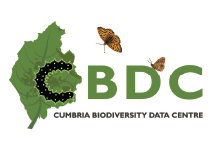By Martin Harris, CBDC Recording Officer
April 2025
The fine weather and dry conditions recently have meant that some of our flying invertebrate species have begun emerging, some more expectedly than others. CBDC has received one particularly interesting report from David Clarke:
Scaeva selenitica a hoverfly not often recorded in Cumbria, was recorded in the first week of March. This is the earliest record of the species for the county, with the previous earliest being on 15th June 2019. It’s also a particularly early record for the species nationally, with only 4 earlier records on the NBN Atlas.

CBDC only has 24 records of this species, and it’s possible that is going under-recorded in the county, although it is known to be more common in southern England than elsewhere, as can be seen from its NBN Atlas distribution map:

As is the case for many invertebrates, there is a trend towards earlier sightings of this species (both in Cumbria and nationally) which is likely influenced by global heating. A crude analysis of CBDC and NBN Atlas data shows this trend, as indicated in the charts below. This can have severe consequences for both invertebrate species and plants as a result of mismatches between plant blooming and insect emergence.


We can also see in both datasets an increase in the frequency of records as time has gone on. This may be indicative of a northward expansion of the species range (also a known effect of global heating on invertebrate species) but it’s also likely to be reflective of increased recording effort and better quality of records.
This goes to highlight the importance of consistent and good quality recording in order to build up the most complete and accurate picture of how our species are changing over time!
